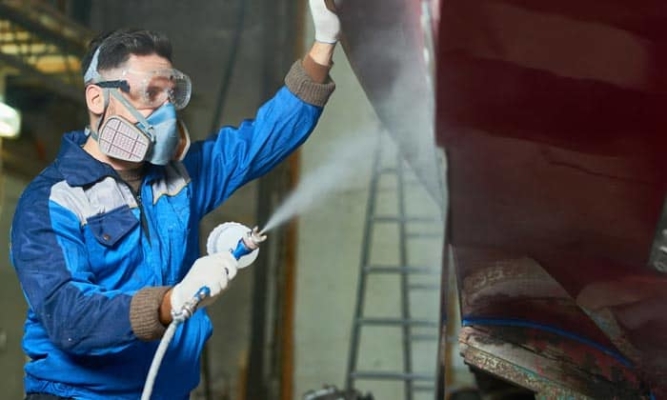General Information (29 CFR 1910.134): Respirators protect workers lungs from hazardous airborne chemicals or particles. Employers are responsible for providing adequate respiratory protection that corresponds with the hazardous chemical exposure of the task being performed. Tasks in your shop where OSHA requires that employees wear respirators include painting, sanding, welding and whenever ventilation controls and work practices are not adequate enough to reduce exposures below the PELs for particulates or chemicals (See 29 CFR 1910, Subpart Z).
Respiratory Protection Programs: Auto shops must develop a respiratory protection program. Respiratory protection programs include written workplace procedures, proper selection of NIOSH approved respirators, training, fit testing, inspection and maintenance, medical evaluations, work area surveillance, and provisions for clean breathing air when using supplied-air respirators.
- Even when exposure levels do not exceed OSHA PELs, workers may still decide to wear respirators. In this case, a limited respiratory protection program is still required, including proper training and fit testing, so that workers don’t cause themselves harm by improperly using the respirators
The Right Respirator: OSHA has created guidance on what types of respirators should be used for what hazard they are being exposed to.
| Single-strap dust masks are usually not NIOSH-approved. They must not be used to protect from hazardous atmospheres. However, they may be useful in providing comfort from pollen or other allergens. | |
| Approved filtering facepieces (dust masks) can be used for dust, mists, welding fumes, etc. They do not provide protection from gases or vapors. DO NOT USE FOR ASBESTOS OR LEAD; instead, select from the respirators below. | |
| Half-face respirators can be used for protection against most vapors, acid gases, dust or welding fumes. Cartridges/filters must match contaminant(s) and be changed periodically. | |
| Full-face respirators are more protective than half-face respirators. They can also be used for protection against most vapors, acid gases, dust or welding fumes. The face-shield protects face and eyes from irritants and contaminants. Cartridges/filters must match contaminant(s) and be changed periodically. | |
| Loose-fitting powered-air-purifying respirators (PAPR) offer breathing comfort from a battery-powered fan which pulls air through filters and circulates air throughout helmet/hood. They can be worn by most workers who have beards. Cartridges/filters must match contaminant(s) and be changed periodically. | |
| A Self-Contained Breathing Apparatus (SCBA) is used for entry and escape from atmospheres that are considered immediately dangerous to life and health (IDLH) or oxygen deficient. They use their own air tank. |
Fit Testing and Training: Fit tests and training are required annually for all those who wear tight-fitting respirators. Some fit tests and trainings may be available through some supply companies and occupational health clinics. Note that any facial hair that could interfere with the respirator seal is not permitted.
Medical Evaluations: Employees who wear respirators or work in a task that requires the use of respiratory protection need to have a medical evaluation. An occupational physician or other licensed health care professional can perform medical evaluations for shops’ respiratory protection programs.
Recent Posts
The U.S. Department of Labor Announces Proposed Rule To Protect Indoor, Outdoor Workers From Extreme Heat
The U.S. Department of Labor has proposed a new rule aimed at protecting workers from extreme heat hazards. This initiative seeks to safeguard approximately 36 [...]
Supreme Court Overturns Chevron Deference: What It Means for Workplace Safety and Regulation
The landscape of federal regulation is set for a seismic shift following a recent Supreme Court decision. On June 28, in Loper Bright Enterprises, et [...]
Navigating the Compliance Maze: How NARFA Simplifies Employee Benefits for Automotive and Trade Industries
In today's complex regulatory environment, businesses in the automotive, roads, fuel, and related industries face unprecedented challenges in managing employee benefits. Recent studies show that [...]




